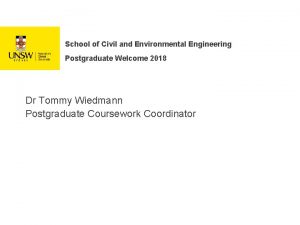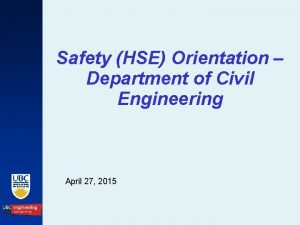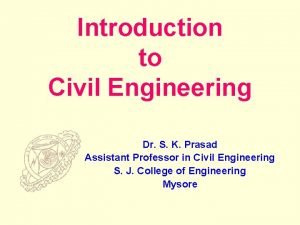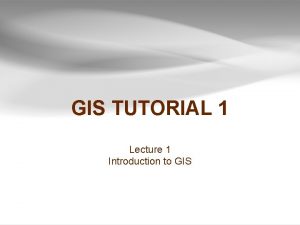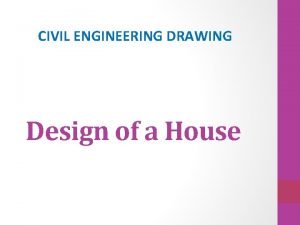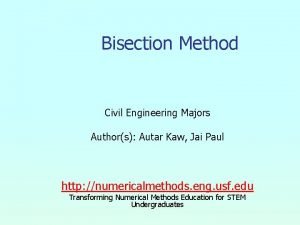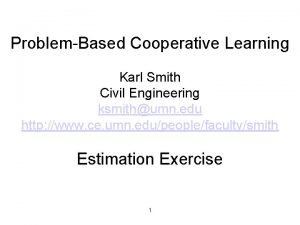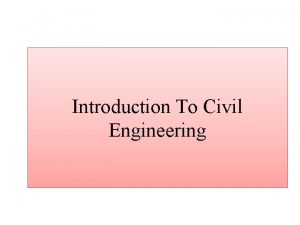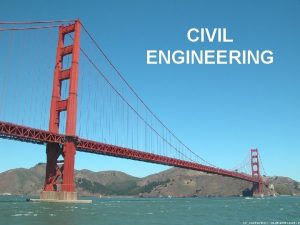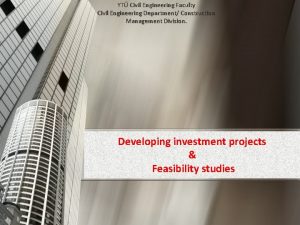1 Lecture 1 Civil Engineering Practice Introduction Instructor














- Slides: 14

1

Lecture # 1 Civil Engineering Practice Introduction Instructor: Dr. Attaullah Shah Department of Civil Engineering Swedish College of Engineering and Technology-Wah Cantt. 2

Civil Engineering Practice Course • Credit Hours 3 ( 2+1) • Semester Weeks 16/18 • Evaluation/Grading – Home Assignments (4) 10% – Quiz test (4) unannounced 15% – Midterm test: 25% • Semester Exam 40% • Industrial visit: Visit to a Construction sites 3

Course outline • Earth moving: – Labour versus machinery. Factors affecting selection of construction equipment. – Principle and use of common earth moving machinery required for different purposes (digging, hauling and compaction etc. ). • Stone crushers: Machines for cleaning and grading of aggregates, • Concrete mixers, vibrators and pneumatic tools, • Introduction to tunneling, Piles and cofferdams, • Form work and shuttering. Defects and remedial measures in construction, Principal defects and diagnosis of causes. 4

• Forms for Concrete: – structures, Form requirements, cost of forms, designing a project form economy, materials forms, size of form section, properties of lumber, Fundamental form design. • Foundation grouting: – Need for grouting, exploring to determine the need for grouting, materials used for grout, drilling patterns, drilling injection holes, preparations for grouting, . Washing the seams, grouting pressures, equipment for cement grouting, injecting cement grout, pressure grouting with asphalt, clay grouting, chemical grouting, determine the effectiveness of grouting. – Introduction to work and tendering. 5

6

Excavation Works and Equipment • Various machines do excavation work for varying purposes. • Excavation contractors may need to perform grading, trenching, digging, dredging or site development work. • The type of equipment used to perform the excavation work will depend on the type of excavation done. • Most people are familiar with site-development excavation work. This involves digging a hole for the foundation of a house and grading the area around the home to ready the yard for landscaping. 7

Site Excavation • Site excavation is a process in which soil, rock, and other materials are removed from a site, typically with the use of heavy earthmoving equipment such as excavators and bulldozers. There a number of reasons to conduct a site excavation, ranging from a desire to explore a site to learn more about its archaeological history to an environmental remediation project. • Depending on the purpose of a site excavation, it may be conducted and supervised by various professionals. • During new construction on buildings, roads, and other structures, site excavation is one of the earliest stages. The site is excavated to create a level, clean area to work, with the foundations being established in the excavated area. • A site may also be excavated and backfilled to confirm that the material directly under the site is of high quality. The depth of site excavation can vary, depending on what is being built and where the building is occurring. 8

Equipment Used for Excavation • Excavator: • An excavator is a machine that may also be used for digging or demolition. • Excavators can come in a number of sizes, but tend to be designed the same. • Usually there is a pivoting cab that rests on an undercarriage. Extending from the middle is an arm that is usually connected to a bucket. • On each side of the undercarriage are tracks that are used for mobility. • On top of the base is a platform that rotates between 180 and 360 degrees. 9

• A bulldozer is another item that can come in a range of sizes. • This vehicle has a tractor style body and also has the track-type undercarriage. • There is normally some type of metal blade connected to the front of a bulldozer. • This is used to push heavy loads that can include sand or refuse from a demolished structure. • The blades are often switched to accommodate the job. 10

• Dump trucks are earth moving equipment that allow for the transport and deposit of necessary materials at a job site. • One of the most important features of the dump truck is that it is an efficient means of transportation. • A dump truck can be driven for long distances at speeds that do not conflict with normal traffic or consume unnecessary amounts of time. • The other important feature is that the loads that they carry can be deposited with minimal effort since the driver performs this task without having to leave the cab 11

12

13

14
 Introduction to civil engineering
Introduction to civil engineering Civil rights and civil liberties webquest
Civil rights and civil liberties webquest 01:640:244 lecture notes - lecture 15: plat, idah, farad
01:640:244 lecture notes - lecture 15: plat, idah, farad Master of civil engineering unsw
Master of civil engineering unsw Hse in civil engineering
Hse in civil engineering Civil engineering completed risks
Civil engineering completed risks Tam grouting
Tam grouting What is formwork in civil engineering
What is formwork in civil engineering Role of civil engineering
Role of civil engineering Gis applications in civil engineering
Gis applications in civil engineering Faculty of civil engineering ctu prague
Faculty of civil engineering ctu prague House civil engineering drawing
House civil engineering drawing Bisection method application in civil engineering
Bisection method application in civil engineering Umn civil engineering
Umn civil engineering Ndsu civil and industrial engineering building
Ndsu civil and industrial engineering building



